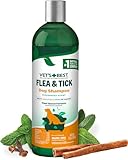Finding one or two small black bugs with a hard shell in your home is not cause for concern. The best way to get rid of them is to thoroughly clean your home. It also helps to spray natural repellents such as peppermint oil to keep them from coming back.
In case of larger infestation it’s best to identify and target which bug is infesting your home, so you can truly eradicate them and take preventive steps to keep an infestation from recurring. Fortunately, that’s exactly the information that this article will provide you with.
Identification of Black Bugs With Hard Shells in Your House
Carpet Beetles
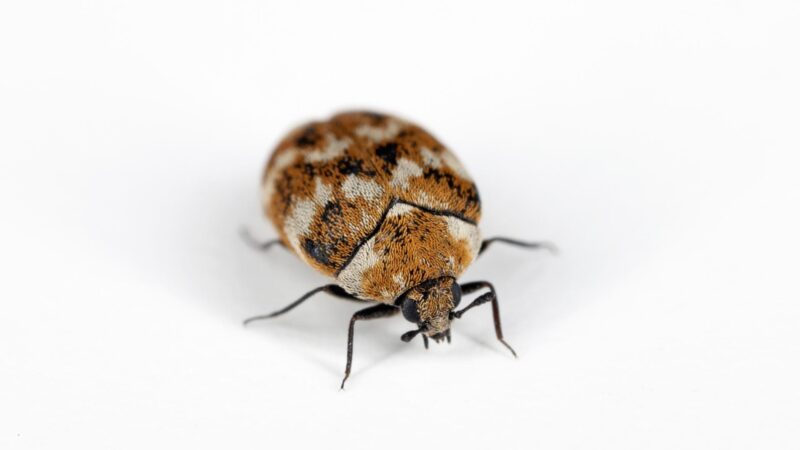
One of the most common small black bugs with hard shells is the carpet beetle. Although adult carpet beetles feast on plant-based material like pollen, their larvae feed on the dried-up protein found on fabric made of wool and fur.
These tiny bugs often make their way inside houses through open windows and doors. Some may have been carried in when you brought flowers or groceries. They also stick to clothing, especially if you hiked or camped near animal nests.
- Appearance: Carpet beetles are tiny oval-shaped animals with plump bodies. They are either black or dark brown and with bodies that often appear shiny. Some carpet beetles have small white patches all over its body. Aside from the adult carpet beetle, its larvae have long bodies covered in bristle-like hair and white stripes along their midsection.
- Size: 1/8 to 3/16 inches
- Scientific Name: Dermestidae
- Lifespan: 2 to 6 weeks
- Habitat: If outdoors on crape myrtles or other plants, and if indoors often near doors and windows.
- Diet: Wool, fur, pollen, grains, flour, nectar,
- Threat: In general, carpet beetles are not considered harmful to humans. They do not bite and often feast on dried-up protein from dead insects and animals. With that said, they love eating fabrics like wool, fur, and silk, and this can cause quite the damage to carpets, rugs, and even bed covers.
Control:
As its name implies, carpet beetles often infest carpets. So the first thing you have to do to get rid of them is to deep clean the affected carpet if that is still possible. But if the infestation seems to be beyond saving, it’s best to throw the carpet away. Also, you should vacuum nearby furniture just in case there are carpet beetle larvae found on sofa linens or covers.
Nevertheless, the best way to prevent an infestation is to make sure it doesn’t occur in the first place. To do so, you should regularly vacuum carpets and sheet covers so it doesn’t become potential host to carpet beetles. It also helps to get them deep cleaned every month or so to kill any bug or larva that has lived there undetected.
Related: Carpet Beetles in Bed: Do Carpet Beetles Get in Your Bed?
Centipedes
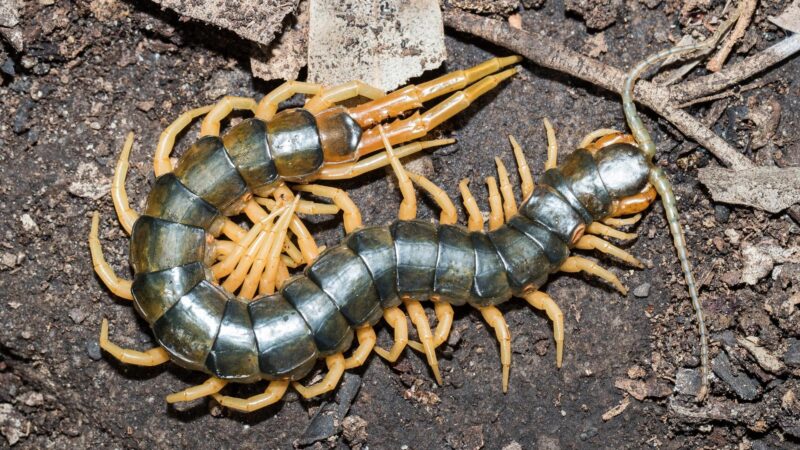
Centipedes are quite hard to miss since they often grow to about eight inches long. While the common house centipede only grows to about three inches, they do bite – and these bites can be excruciatingly painful. And since centipedes are venomous, the venom can also trigger allergic reactions.
But contrary to popular belief, a centipede doesn’t exactly have 100 legs. At most, it only has 15 pairs of legs – for a total of 30.
- Appearance: Centipedes have long slender bodies that are predominantly dark brown or reddish-brown with yellow stripes. It also has 15 pairs of long yellow legs with dark markings, although some centipede species have shorter legs. They have a pair of long antennae and two pincers on their heads.
- Size: 0.4 to 12 inches
- Scientific Name: Chilopoda
- Lifespan: 5 to 6 years
- Habitat: Desert, seashore, and tropical areas
- Diet: Small insects and invertebrates, as well as other arthropods
- Threat: If left alone, centipedes don’t usually harm humans, but they do bite when they feel attacked – even if you just accidentally stepped on them. Unfortunately, their bites are quite painful and can trigger an allergy attack that can lead to swelling and itching.
Control:
Centipedes are repelled by peppermint. Despite its relaxing scent, peppermint oil is known to be harmful to centipedes as it can burn their bodies. You can spray the centipede with peppermint oil diluted in water, and it will retreat immediately. Then, you can continue to diffuse peppermint oil in your home to keep them away for good.
Also, it must be noted that centipedes are attracted to moist areas. So, make sure to check your pipes in case of leaks since it may be the reason why you found a centipede in the first place.
Related: How to Get Rid of House Centipedes Naturally? | Control Guide
Cockroaches
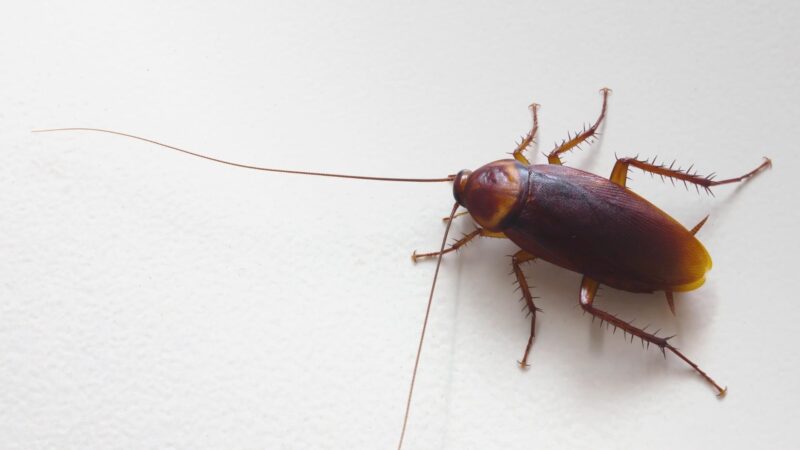
Another household hard-shelled bug that’s hard to ignore is cockroaches. These big bugs are infamous for being scavengers, often eating whatever food and waste they can find. Unfortunately, that also means that they get to pick up diseases from their unhygienic meals.
The worst part about cockroaches is that they can enter your house through any opening – including cracks, vents, and other tiny gaps they could find. That’s how hardworking they are when it comes to searching for food.
- Appearance: Cockroaches have long oval-shaped bodies that are usually flat. Their bodies are either bright maroon or reddish-brown and often appear shiny. They have a pair of long, thread-like antennae and six pairs of legs.
- Size: ½ to 2 inches
- Scientific Name: Blattodea
- Lifespan: 20 to 30 weeks
- Habitat: Warm, dark, wet areas, like sewers and basements
- Diet: Plants and animals
- Threat: As earlier established, cockroaches become a threat because they carry bacteria due to their unhygienic scavenging lifestyle. But aside from disease-causing bacteria, some people are also allergic to their saliva, body shedding, and feces, which can even lead to a severe asthma attack. Additionally, cockroaches also bite as a defense mechanism. Their bites can be painful and can cause swelling and itching at the bite site.
Control:
To get rid of cockroaches, studies show that essential oil from Citrus hystix or Thai lime plant is most effective at chasing away a variety of cockroach species. You can spray this directly at cockroaches to get them running. You can also diffuse the Thai Lime oil to keep them from coming back.
As an additional precaution, you should always keep your home clean. Make sure that there are no crumbs after a late-night snack, nor are there spills or other waste from when you were cooking. Additionally, have your house checked for cracks and gaps that could serve as a cockroach’s entryway into your home.
Related: How to Get Rid of Cockroaches with Home Remedies
Pill Bugs
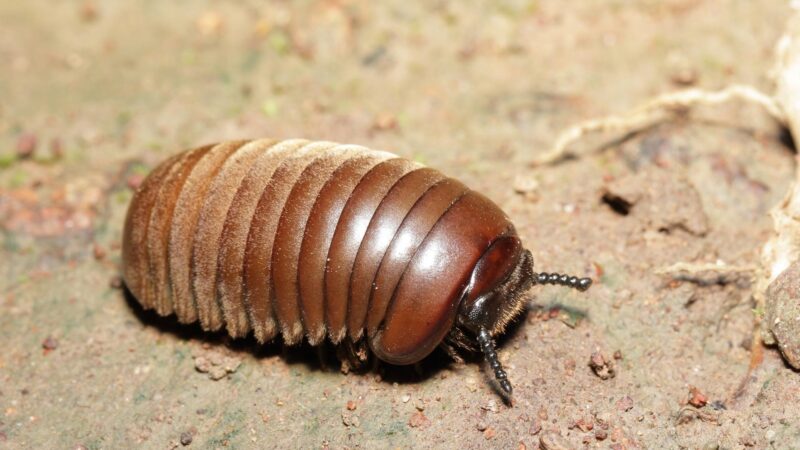
The pill bug is not a usual home intruder since it thrives in moist, humid, and soily areas. However, it can be brought into your home after you’ve gone hiking or gardening – or it can voluntarily seek shelter in your house if it starts to rain too hard.
Otherwise known as rollie pollies, pill bugs roll into a ball to leave only their hard shell exposed as a defense mechanism. Interestingly, they do not bite humans, nor are they considered carriers of diseases.
- Appearance: Pill bugs have shiny bodies characterized by thick, armor-like scales. They have oval-shaped bodies that are long enough to allow them to curl into a ball when they feel threatened.
- Size: 1/4 to 1/2 inches
- Scientific Name: Armadillidiidae
- Lifespan: 3 years
- Habitat: Mulch, fallen leaves, and rocks
- Diet: Decaying plant leaves and other decomposing materials
- Threat: The pill bug is not considered a threat since it does not bite, sting, carry diseases, or cause property damage. They are mainly attracted to decaying plant matter, such as fallen leaves, and that’s what they often eat. But because of this, they are more likely considered garden pests.
Control:
To get rid of pill bugs, make sure to keep your home clean and dry and free from any decaying plant matter. Clean up any fallen leaves from indoor plants as soon as possible, and make sure to vacuum the house regularly.
It also helps to check your home for leaks since these bugs are attracted to moist areas. Make sure to fix broken pipes or seal cracks to prevent water from seeping in.
Related: Pill Bug Control: How to Get Rid of Pill Bugs?
Grain Insects
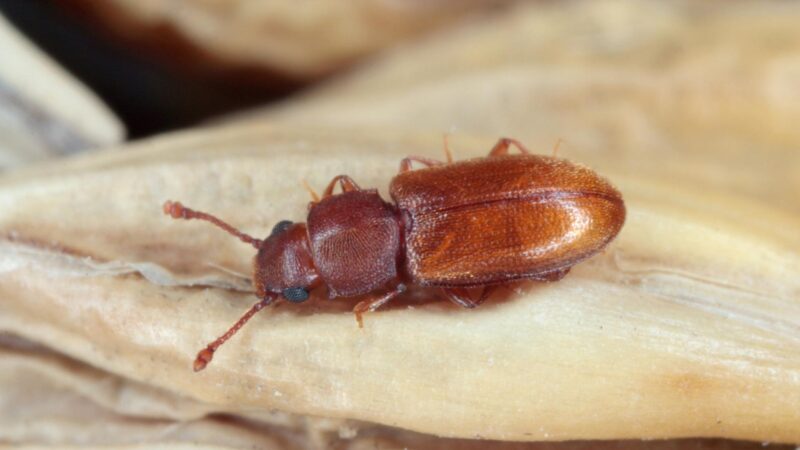
Another small black bug with a hard shell that you can find in your house is the grain insect. Otherwise known as grain beetles, these bugs are known to infest stored food products. Unfortunately, they can cause contamination and food wastage. While they mainly target grains and cereals, they will not hesitate to eat other dry foodstuffs such as nuts and spices.
- Appearance: Grain insects have dark brown, dark red, or black oval-shaped bodies. Their bodies are more narrow than plump, and their antennae are distinct because of their clubbed appearance.
- Size: 5/32 inches
- Scientific Name: Oryzaephilus
- Lifespan: 6 to 10 months
- Habitat: Grain storage facilities
- Diet: Flour, cereals, bread, pasta, dried fruits, sugar, nuts, drugs, dried meat, and tobacco
- Threat: As its name implies, these bugs pose a threat to stored food products such as grains, cereals, pasta, nuts, and other dried food. While they do not bite pets or humans, they can contaminate the food and render it unsafe for human consumption. And that can be quite a waste.
Control:
The best way to keep grain insects from infesting your stored food is to keep the storage area clean at all times. Make sure to get rid of crumbs or spillage to avoid attracting these bugs. Also, make sure that the food is stored in airtight containers to make sure that these bugs never get to your food.
Ticks
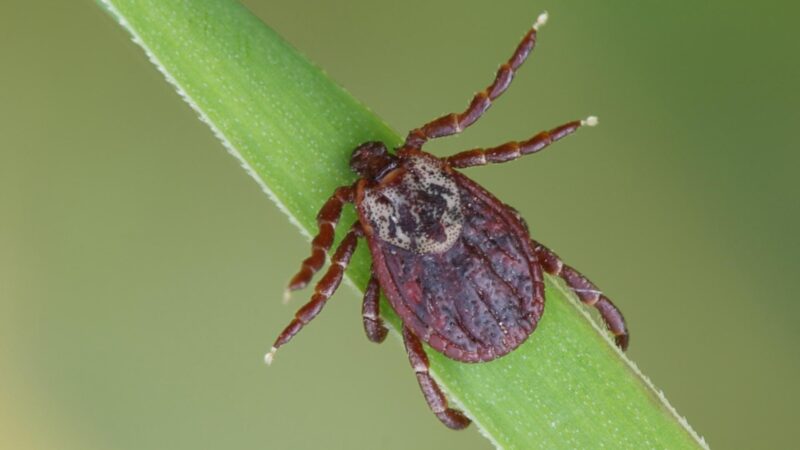
Ticks are quite common among households with furry pets. These parasitic bugs often make their way into homes when their pet becomes in contact with a host pet – usually after a walk or a day at the park. Unfortunately, a single female tick can lay up to 5,000 eggs, which can lead to quite an infestation.
- Appearance: Generally, ticks have flat, reddish-brown bodies with eight legs. However, female ticks are capable of being engorged when they have sucked in enough blood, which leaves them looking plump, large, and gray-colored.
- Size: 1/8 inches
- Scientific Name: Ixodida
- Lifespan: 3 to 5 months
- Habitat: Wooded and grassy areas
- Diet: Mammals, birds, reptiles, and amphibians
- Threat: As parasites, ticks mainly feed on the blood of other warm-blooded animals. If their host is harboring a disease, it can easily transfer the bacteria or virus onto its new host. As a result, the host may suffer from anemia, which can even be as severe as paralysis.
And if the new host is a pet, ticks are also known to bite humans and spread the bacteria and germs they carry. Their bites are also itchy and irritating.
Control:
A tick infestation usually starts with a pet that has been exposed to a host. To get rid of ticks on pets, make sure to use a mild anti-tick shampoo or soap, like the Vet’s Best Flea and Tick Advanced Strength Dog Shampoo . Then, comb or brush their fur regularly to get rid of dead ticks.
- DOG AND PUPPY SHAMPOO: Say goodbye to fleas and ticks with our...
- CERTIFIED NATURAL FLEA AND TICK PREVENTION FOR DOGS : Made with...
- VETERINARIAN FORMULATED: Our dog flea & tick shampoo provides...
- 2X FLEA & TICK FIGHTING POWER: Our flea & tick shampoo delivers...
- MADE IN THE USA: Proudly manufactured in the USA using premium...
To prevent a recurrence, continue using the anti-tick shampoo or soap on your pet. Particularly, use it after it has been at the park or has played with other dogs. It also helps to vacuum dog beds and other pieces of furniture that it has slept on to make sure that no tick stays long enough to start another infestation.
Related: How to Remove an Engorged Tick on Dogs? | A Detailed Guide
Fleas

Just like ticks, fleas are another ectoparasite which often found on furry pets. These blood-sucking insects often feed on their host, but they are also known to bite humans when they have the chance.
But what’s interesting to note is that one female flea can lay around 50 eggs in a day, which can last for up to 50 days. As a result, fleas spread easily and can even make their way throughout your entire house.
- Appearance: Fleas are small insects with plump and oval-shaped bodies, with long legs and a prominent heavy-looking bottom. They are either dark brown or reddish-brown.
- Size: 1/8 inches
- Scientific Name: Siphonaptera
- Lifespan: 2 to 3 months
- Habitat: Moist, humid, and shady areas
- Diet: Warm-blooded bodies
- Threat: Like ticks, fleas are considered a threat because they can be carriers of diseases. They are also quick to reproduce, so the presence of a few is enough to start an infestation within weeks. Additionally, a flea bite can cause itching and swelling. And in severe cases, it can trigger allergic reactions in some people.
Control:
When it comes to parasites like fleas, prevention is always the key. If you have pets at home, it’s best to bathe them with an anti-flea soap or shampoo, like the Zodiac Flea & Tick Shampoo for Dogs and Cats . Once these anti-flea shampoos take effect, you can simply comb away all the dead fleas from your pet.
- Kills fleas and ticks through contact
- Rich, creamy formula that cleans and conditions
- Use on cats, kittens, dogs and puppies over 12 weeks of age
- Pleasant, fresh scent
Another way to control the spread of fleas in your house is to use an anti-flea household spray like the Sentry Home Household Flea and Tick Spray . This spray repels fleas and can be used on rugs, carpets, sofas, and other pieces of furniture or fabric where fleas usually go in hiding.
- LONG LASTING PROTECTION: SENTRY Household Flea and Tick Spray...
- PROTECT YOUR HOME: Spraying SENTRY HOME Flea and Tick Spray on...
- EFFECTIVE AGAINST PESTS: SENTRY Home Spray kills fleas, flea...
- FLEAS: Fleas are insects that can start your pet scratching with...
- TICKS: Ticks are parasites that belong to the arachnid family...
Related: How To Kill Fleas? Best Flea Killers
Cigarette Beetle
The unusual name of the cigarette beetle is derived from the fact that it loves feeding on tobacco. Otherwise known as cigar beetles or tobacco beetles, these bugs love dried plant material and can cause quite the damage within your home. But fortunately, cigarette beetles do not bite, sting, or transmit diseases.
- Appearance: The cigarette beetle is a tiny oval-shaped insect with a shiny brown or reddish-brown body. Like other beetles, it has a bulky appearance and is supported by six thin legs. It has a pair of long antennae.
- Size: 1/8 inch
- Scientific Name: Lasioderma serricorne
- Lifespan: 2 to 4 weeks
- Habitat: Tobacco storage warehouses
- Diet: Dried plants and seeds, grains, cereals, paper, herbs, spices, and paper
- Threat: The cigarette beetle is not harmful to humans in the sense that it doesn’t bite nor carry disease-causing pathogens. However, it can cause quite a damage to your home, especially for dried plant materials like herbs and other dried food in your pantry.
Control:
To get rid of cigarette beetles, the first thing to do is clean the infested area. It’s best to vacuum the area, so you can also get rid of eggs and larvae. Also, check the food boxes for any holes that may have caused contamination to the food inside – and throw them away.
For prevention, it’s best to transfer your food out of boxes and use airtight containers instead. You should also clean the pantry frequently to get rid of food crumbs that could easily attract cigarette beetles.
Drugstore Beetle

The drugstore beetle is another known bug with a hard shell that can infest the home. Like the cigarette beetle, it often feeds on dried plant products. However, it is mostly found raiding prescription drugs – hence, the name.
- Appearance: The drugstore beetle shares a resemblance to the cigarette beetle, although the latter is slightly larger. It has a bulky oval-shaped body supported by six thin legs. It has also a pair of wings and a pair of antennae. To distinguish it from other bugs, it has a bent downward head, which gives it a more humpback appearance. It also looks reddish-brown with patterns that make it appear like wood.
- Size: 1/10 inches
- Scientific Name: Stegobium paniceum
- Lifespan: 2 to 4 weeks
- Habitat: Commonly found in warm climates or heated structures
- Diet: Eats anything but cast iron
- Threat: Drugstore beetles can cause quite a damage to your property. It has been observed to feed on dried-up plant material like herbs, spices, and paper. However, it is also known to eat pet food, leather, wool, and other animal products.
Control:
To get rid of drugstore beetles, the first thing you have to do is identify their food source and start from there. Once identified, you should be quick to get rid of it since its contents are already contaminated. You should also clean out your pantry or medicine cabinet in case of an infestation, especially if the boxes have been ripped open. These may already harbor eggs or larvae and are unfit for human use.
Once cleaned out, you should look for cracks or gaps and seal them immediately. This will prevent other carpet beetles from getting into your pantry or medicine cabinet. You should also remember to clean it and have it vacuumed once in a while so it doesn’t attract any more bugs.
How to Eliminate Small Black Bugs With Hard Shell in Your House?
Vacuum regularly. Small black bugs with hard shells can be easily removed from the house by vacuuming. It also gets rid of eggs and larvae that are usually too small to see. And even after you have gotten rid of an infestation, it helps to keep vacuuming your home regularly to keep another infestation from taking place.
Clean spillage and get rid of crumbs immediately. The reason why bugs are drawn to your home is that they can find food sources there. They are usually attracted by spillage inside the pantry or by crumbs that have fallen on your bed sheets or sofa. By getting rid of them right after cooking or eating, you’re already preventing them from going near your home.
Have carpets, bed sheets, and other covers deep-cleaned regularly. Some bugs love hiding on carpets, rugs, and similar fabrics, so it’s best to have them cleaned regularly.
Bathe pets in medicated anti-tick or anti-flea shampoos or soaps after a day outside. Bugs like ticks and fleas often get inside your home through your beloved pets. So to get rid of them and avoid another infestation, you can use anti-flea shampoos, soaps, or powder to kill these ectoparasites almost instantly.
Seal cracks and fix leaks as soon as possible. To keep bugs like centipedes and cockroaches off of your home, you should seal all cracks and gaps to keep them from coming in. It also helps to fix leaks since some bugs are attracted to moist and humid areas.
Use peppermint oil or citronella. Another way to surely get rid of bugs and other pests is to diffuse peppermint or citronella oil. Both of these oils are known to repel insects.
Peppermint is considered pungent and can easily drive bugs away. On the other hand, citronella masks the smell of their food, so they are led to believe that they won’t find any food at your home. And that can surely prevent an infestation.
It’s common to find bugs in your home once in a while. What’s essential is knowing how to deal with that bug to avoid a future infestation. Luckily, this article has introduced you to nine small black bugs with hard shells to help you identify and get rid of them in case they find a way into your home.
List of Sources
Thavara, U., et al. (2007). Repellent activity of essential oils against cockroaches (Dictyoptera: Blattidae, Blattellidae, and Blaberidae) in Thailand. Southeast Asian Journal of Tropical Medicine and Public Health.
Insects, Spiders, Centipedes, Millipedes. (2017). National Park Service – U.S. Department of the Interior.
Franklin, J. A., Byron, M. A., Gillett-Kaufman, J. L. (2021). Pillbug. University of Florida.
Jackman, J., Vinson, B. S. (2018). Grain Beetles. Texas A&M University Extension Entomology.
Potter, M. F. (2018). Flea Control and Prevention. Entomology at the University of Kentucky.
- How to Get Rid of Copperheads | Practical Guide - August 27, 2023
- How to Get Rid of Corn Snakes | What Makes Them Aggressive? - August 27, 2023
- How to Get Rid of Alligators | Safety Measures and Removal Methods - July 16, 2023

